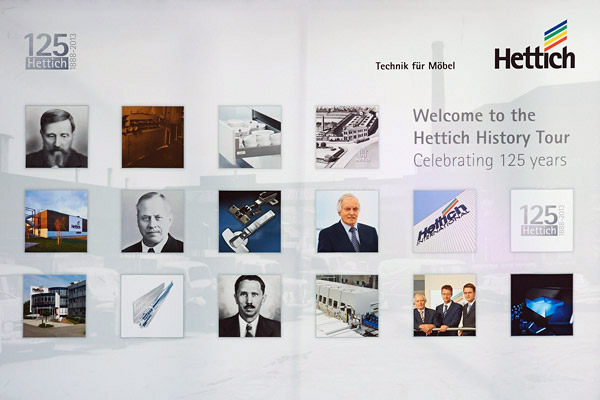To survive two world wars, numerous market challenges and even a global financial crisis is no small feat, but when you’ve been in business for 125 years, it tends to put even the biggest challenges into perspective. Alice Blackwood meets with Dr Hettich, during Hettich’s 125-year celebrations in Australia.

November 26th, 2013
When you design a product to ‘last a lifetime’, and that product is specifically designed to be so subtle and seamless the user barely notices it, how do you raise its profile among your customers and market?
In fact, “one of the challenges of our products,” says Dr Andreas Hettich, fourth-generation owner of Hettich, “is the end consumer only gets to know [our hardware] when it fails.”
It’s one of the stories Hettich shares with customers when they’re purchasing hardware solutions for furniture, doors, cabinetry and more: that thinking about Hettich hardware is “like thinking about the engine of a car.”
The company has spent 125 years perfecting its knowledge, engineering and design of hardware solutions for everything from Piano hinges (in the early 1900s) through to kitchen cabinets.
“Innovation has been key for the company and the family,” says Dr Hettich, who, like his grandfather and father, is a trained engineer. “We’re looking at the things that make your cabinets and doors and drawers work perfectly.”
The “secret silent” stuff – so to speak. “It’s the movement,” Dr Hettich says, referring to the smooth, seamless open and close of drawers and doors. And it’s the invisibility of those hardware fixtures which have been designed to be barely there.
If the design of furniture and cabinets comes first – which it often does, how does Hettich tackle its own product innovation?
As drawers become wider, larger, heavier, and incorporate new materials into their structures, for example, Hettich then moves beyond the furniture design and translates those design ideas into technical solutions.
As was the case with the Sensys hinge with integrated dampening (soft-closing ability), and the ArciTech drawer, which is smooth running and exceptionally stable (to cater for varying weight loads).
Answering demand while also creating demand has been an important balancing act for the Hettich business.
Particularly in a GFC climate where many companies have been forced to diversify their offerings and provide economical solutions, Hettich has developed improved hinge systems which require less hardware and are economically produced. “It’s really the perfection of functionality and economics of furniture,” states Dr Hettich.“We are responding to demand but more importantly we are creating demand.”
Richard Abella, Managing Director of Hettich Australia and New Zealand, with Dr Hettich at the anniversary celebration
The company has been active in international markets since the 1970s, although its presence in Australia (over the last 25 years) is strongly consumer driven. “We’ve always produce high quality products,” says Dr Hettich. “And well some of them are still there – even 100 years on.” “Usually it’s the furniture that breaks, not the hinge, or the fitting,” he says.
“On the one hand, from a business perspective, that presents quite a challenge, but [from a consumer perspective], our hardware remains operating in kitchens still 30 years later.
“Our philosophy is around producing products which last for a long time – they [outlive] the furniture. It’s one of the secrets to staying in business for as long as we have.”
Hettich
hettich.com
A searchable and comprehensive guide for specifying leading products and their suppliers
Keep up to date with the latest and greatest from our industry BFF's!

XTRA celebrates the distinctive and unexpected work of Magis in their Singapore showroom.

Elevate your outdoor spaces with pieces that are beautiful, functional, and engineered for you.

With the exceptional 200 Series Fridge Freezer, Gaggenau once again transforms the simple, everyday act of food preservation into an extraordinary, creative and sensory experience, turning the kitchen space into an inspiring culinary atelier.

In this candid interview, the culinary mastermind behind Singapore’s Nouri and Appetite talks about food as an act of human connection that transcends borders and accolades, the crucial role of technology in preserving its unifying power, and finding a kindred spirit in Gaggenau’s reverence for tradition and relentless pursuit of innovation.
The internet never sleeps! Here's the stuff you might have missed

Nestled amidst the fern gullies and towering Mountain Ash rainforest of the Dandenong Ranges, the new Puffing Billy Railway Visitor Centre emerges as a striking, intentionally rugged structure honouring its geographical context and rich locomotive heritage.

Expanding on his published collection of essays, Richard Francis-Jones curated a stimulating discussion about what elicits an architectural response.